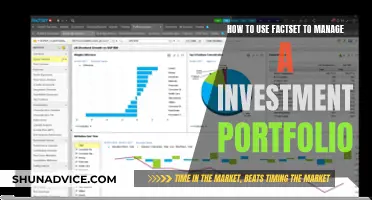
International portfolio investments are a selection of stocks and other assets that focus on foreign markets. They are a way for investors to diversify their portfolios and gain exposure to emerging and developed markets outside of their domestic market. This type of investment carries increased risks due to potential economic and political instability in some emerging markets, as well as currency exchange rate risk. However, these risks can be mitigated by investing in a mix of emerging and industrialized markets and by staying informed about global economic and political developments. Foreign portfolio investment (FPI) is a common way for investors to participate in overseas economies, especially retail investors, as it does not usually confer management control over the assets.
What You'll Learn

Political instability and its impact on portfolio investments
Political instability can have a profound impact on portfolio investments, and this impact can manifest in several ways. Firstly, political instability often leads to economic uncertainty, as investors become cautious and hesitant to invest due to the unpredictable nature of the political landscape. This uncertainty can result in a decrease in investment and a slowdown in economic growth. Additionally, political instability can disrupt operations and economic activities, further reducing investor confidence and deterring foreign investment. This was evident in Pakistan, where political instability negatively impacted the stock market performance and led to a decline in the Karachi Stock Exchange (KSE).
Moreover, political instability can cause fluctuations in currency exchange rates, affecting the value of international portfolios. Investors in foreign markets not only face the risk of political and economic instability but also bear the burden of increased transaction costs, including commissions, brokerage charges, taxes, and various fees. These additional costs can eat into overall returns, making international portfolios less attractive during times of political turmoil.
The impact of political instability on portfolio investments is not limited to a single country; it can have spillover effects on neighbouring countries and even international markets. For instance, political unrest in one country can lead to a decline in its stock market, which may prompt investors to withdraw their money and seek safer investment opportunities elsewhere, potentially impacting global markets.
To mitigate the risks associated with political instability, investors can adopt several strategies. One approach is to diversify their portfolios across multiple countries and asset classes. By spreading their investments, investors can reduce their exposure to any single market and lower the overall risk. Additionally, staying informed about global economic and political developments can help investors make more strategic decisions and quickly respond to changing conditions.
In conclusion, political instability can significantly influence portfolio investments, both domestically and internationally. It can lead to economic uncertainty, disrupt operations, impact currency exchange rates, and increase transaction costs. To navigate these challenges, investors can diversify their portfolios and stay abreast of global developments to make more informed investment decisions.
Building an Australian Investment Portfolio: Strategies for Success
You may want to see also

Currency exchange rates and risk
Currency exchange rates and their fluctuations can have a significant impact on the value of investments and the overall risk of a portfolio. Currency risk, also known as exchange rate risk, arises from the change in price of one currency in relation to another. This risk is particularly relevant for investors or companies with assets or operations across multiple countries.
For example, consider an investor based in the United States holding stocks in a Canadian company. The value of their investment is influenced not only by the change in stock prices but also by the fluctuation of the Canadian dollar against the US dollar. If the Canadian dollar depreciates significantly, the investor may lose money even if the stock prices have increased, as the returns will be lower when converted back to US dollars.
The impact of currency exchange rates on investments is further illustrated by the influence of the US dollar on raw material prices. Many raw materials, including oil, are priced in US dollars. When the US dollar depreciates, the price of these raw materials tends to increase, while a stronger US dollar leads to lower commodity prices. This dynamic can affect the operating performance of companies and, consequently, their stock prices.
To mitigate currency exchange rate risk, investors can consider the following strategies:
- Investing in hedged assets: Hedged exchange-traded funds (ETFs) provide a straightforward method to invest in overseas assets while reducing currency risk. These funds are available for a wide range of underlying assets and markets. While they may have slightly higher expense ratios than unhedged ETFs, the cost of hedging is typically lower for large ETFs.
- Hedging exchange rate risk directly: Investors holding foreign-currency stocks, bonds, or American depositary receipts (ADRs) can employ various investment instruments to hedge currency risk. This includes using currency forwards, futures, ETFs, or options.
- Investing globally: Diversifying a portfolio across multiple geographic regions can act as a natural hedge against fluctuating currencies.
- Focusing on currencies with favourable characteristics: Investors can consider investing in countries with strong and stable currencies, such as those with low debt-to-gross domestic product (GDP) ratios or stable political systems.
- Using derivatives: Many institutional investors and multinational corporations use derivatives, such as forex, futures, or options contracts, to hedge currency risk.
In conclusion, currency exchange rate risk is an important consideration in international portfolio investments. While it cannot be entirely eliminated, investors can employ various strategies to mitigate this risk and protect their investments from significant losses due to unfavourable exchange rate movements.
Rebuilding Your Investment Portfolio: Strategies for Success
You may want to see also

Foreign portfolio investment (FPI) vs. foreign direct investment (FDI)
Foreign portfolio investment (FPI) and foreign direct investment (FDI) are two of the most common routes for investors to participate in an overseas economy. While FPI involves investing in financial assets, such as stocks, bonds, and mutual funds, FDI refers to direct investment in a foreign company or operation, giving the investor control over the business's management and operations.
FPI is a passive form of investment, where investors do not actively manage or have direct control over the assets or businesses they invest in. It is often undertaken by retail investors and offers a quicker return on investment. FPI is also more liquid than FDI, as financial assets are highly marketable and can be sold with a few mouse clicks. However, FPI is more volatile and prone to sudden outflows, which can cause economic disruption in the host country.
On the other hand, FDI is considered a more stable and long-term investment. Investors with FDI typically take controlling positions in domestic firms or joint ventures and actively manage them. FDI often involves substantial investment in physical assets, such as factories or equipment, which cannot be easily liquidated. Due to the higher level of investment required, FDI is usually undertaken by large corporations, institutions, or venture capital firms.
Both FPI and FDI offer advantages and play crucial roles in global trade and development. FPI provides investors with international diversification and access to higher returns, while FDI contributes to economic growth, creates jobs, and fosters skill development in the host country.
Investing in Art: Diversifying Your Portfolio with Masterpieces
You may want to see also

Diversification strategies for portfolio investments
Diversification is a crucial aspect of risk management in investment portfolios, aiming to enhance and preserve the portfolio's value. Here are some strategies for diversifying portfolio investments:
Determine Correlation:
Look for asset classes with low or negative correlations. If one investment declines, the other can counteract it. For example, high-yield bonds often have a positive correlation with stocks, so combining them exclusively is not ideal.
Diversify Across Asset Classes:
Select from various asset classes, such as fixed-income investments (bonds), cash and cash equivalents, and real assets like property and commodities. Each class has different risk levels and returns, so including a mix will create a well-diversified portfolio.
Diversify Within Asset Classes:
When investing in energy stocks, for instance, consider adding sectors like tech, biotech, utility, and retail to your portfolio. For fixed-income investments, opt for bonds with different maturities and issuers, including government and corporate bonds.
Diversify by Location:
Expand your portfolio's global exposure. If you only hold securities from your domestic market, you are vulnerable to country-specific risks. Foreign stocks and bonds can increase diversification but come with their own set of risks, such as foreign taxation and currency fluctuations.
Explore Alternative Investments:
Consider real estate investment trusts (REITs) and commodities. REITs provide diversification as they are not strongly correlated with stocks or bonds, and they offer the chance to receive a portion of the earnings of the properties they own. Commodity investments are physical goods like gold, natural gas, wheat, or even cattle, which can be bought directly or through a commodity fund.
Rebalance Your Portfolio Regularly:
Even a well-diversified portfolio requires rebalancing to maintain the balance between risk and reward. Market volatility and major life events can trigger rebalancing.
Consider Your Risk Tolerance:
Your risk tolerance influences your diversification approach. Longer timeframes generally allow for a higher tolerance for short-term losses, while shorter timeframes may require a more conservative approach with a greater allocation to bonds.
Spread the Wealth:
Invest in a variety of companies across different sectors, avoiding putting all your money in one stock or industry. Go beyond your home market and consider global investments to spread your risk and increase potential rewards.
Consider Index or Bond Funds:
Index funds and fixed-income funds offer long-term diversification benefits. These funds track various indexes or reflect the bond market's value, providing a hedge against market volatility. Additionally, index funds often have low fees, reducing overall costs.
Keep Building Your Portfolio:
Regularly add to your investments using strategies like dollar-cost averaging to smooth out market volatility. This approach involves investing the same amount of money over time, buying more shares when prices are low and fewer when prices are high.
Know When to Get Out:
Stay informed about your investments and overall market conditions. This awareness will help you identify when it's necessary to cut losses and move on to other investment opportunities.
Keep an Eye on Commissions:
Understand the fees associated with your investments. Some firms charge monthly fees, while others have transactional fees. Be mindful of how these fees can impact your bottom line, especially when trading mutual funds, illiquid stocks, or alternative asset classes.
Investment Savings: Average Amounts in the United States
You may want to see also

The role of international stocks in portfolio diversification
International stocks are an essential component of portfolio diversification, offering investors exposure to developed and emerging markets outside of their domestic boundaries. This strategy is particularly appealing to those seeking to diversify their assets and tap into economies with faster growth rates than their own country, such as China and India.
An international portfolio provides investors with access to a diverse range of stocks and other assets from foreign markets. It carries the potential benefit of reducing investment risk. For instance, if the domestic market underperforms, gains in international holdings can offset those losses. Additionally, investors can take advantage of market cycles in different nations, investing in developing regions believed to offer high returns.
However, investing in international stocks also comes with certain drawbacks and risks. One significant risk is political and economic instability, especially in emerging markets. A political coup or economic crisis in a foreign country can result in substantial losses. Currency exchange rate risk is another crucial factor, as the value of an investor's portfolio can be affected by fluctuations in exchange rates.
To mitigate these risks, investors can adopt strategies such as mixing emerging-market stocks with investments in more industrialized and mature foreign markets. Additionally, investing in exchange-traded funds (ETFs) that focus on foreign equities can be a cost-effective way to gain exposure to international stocks while reducing some of the risks associated with individual stock picks.
Overall, international stocks play a crucial role in portfolio diversification by providing access to global growth opportunities, reducing risk through diversification, and allowing investors to take advantage of market cycles in different countries. However, it is important to carefully consider and manage the associated risks to make informed investment decisions.
Life Cycle Theory: Savings and Investment Strategies Explored
You may want to see also
Frequently asked questions
An international portfolio is a selection of stocks and other assets that focuses on foreign markets rather than domestic ones.
An international portfolio can give an investor exposure to emerging and developed markets, providing diversification. It can also be used to reduce investment risk.
International portfolios carry increased risks due to potential economic and political instability in some emerging markets. There is also the risk of a foreign market's currency slipping in value against the US dollar.
The most cost-effective way for investors to hold an international portfolio is to buy an exchange-traded fund (ETF) that focuses on foreign equities.







